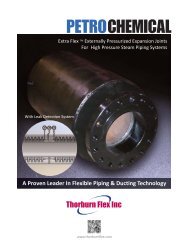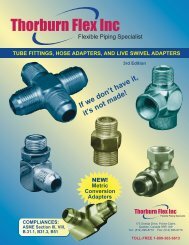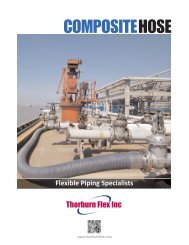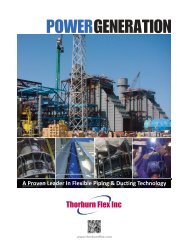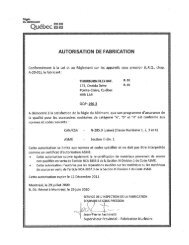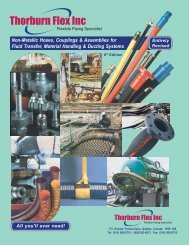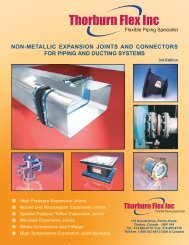Metallic Expansion Joints - Thorburn Flex Inc
Metallic Expansion Joints - Thorburn Flex Inc
Metallic Expansion Joints - Thorburn Flex Inc
Create successful ePaper yourself
Turn your PDF publications into a flip-book with our unique Google optimized e-Paper software.
THORBURN<br />
FLEXIBLE PIPING SPECIALIST<br />
THORBURN'S METAL BELLOWS DESIGN ELEMENTS<br />
4) BELLOWS STABILITY<br />
Excessive internal pressure may cause a bellows to become unstable and<br />
squirm. Squirm is detrimental to bellows performance in that it can greatly<br />
reduce both fatigue life and pressure capacity. The two most common forms<br />
are column squirm and in-plane squirm. Column squirm is defined as a gross<br />
lateral shift of the center section of the bellows. It results in curvature of the<br />
bellows centerline. This condition is most associated with bellows which have<br />
a relatively large length-to-diameter ratio and is analogous to the buckling of a<br />
column under compressive load.<br />
In-plane squirm is defined as a shift or rotation of the plane of one or more<br />
convolutions such that the plane of these convolutions is no longer perpendicular<br />
to the axis of the bellows. It is characterized by tilting or warping of one<br />
or more convolutions. This condition is predominantly associated with high<br />
meridional bending stress and the formation of plastic hinges at the root and<br />
crest of the convolutions. It is most common in bellows which have a relatively<br />
small length-to-diameter ratio.<br />
In-plane instability<br />
Column instability<br />
5) MERIDIONAL BENDING STRESS DUE TO DEFLECTION S 6<br />
When a bellows deflects, the motion is absorbed by deformation of the side<br />
walls of each convolution. The associated stress caused by this motion is<br />
the deflection stress or EJMA stress S 6<br />
. This stress runs longitudinal to the<br />
bellows' center line. The maximum value of S 6<br />
is located in the side wall of<br />
each convolution near the crest or root.<br />
<strong>Expansion</strong> joints are designed to operate with a value of S 6<br />
which far exceeds<br />
the yield strength of the bellows material. This means that most expansion<br />
joints will take a permanent set at the rated axial or lateral motions.<br />
They are rarely designed to be elastic. This also means that the bellows will<br />
eventually fatigue after a finite number of movement cycles. It is important to<br />
specify a realistic cycle life as a design consideration when ordering an<br />
expansion joint. An overly conservative cycle life requirement can result in a<br />
bellows design that is so long and soft that it is subject to squirm failure.<br />
S6<br />
Convolution shape before<br />
deflecting<br />
When the bellows compresses,<br />
the side walls bend to shorten<br />
the bellows<br />
Convolution shape<br />
after deflecting<br />
DESIGN VARIABLES AS THEY AFFECT THORBURN METALLIC BELLOWS DYNAMICS<br />
Stress<br />
EJMA S2<br />
Stress<br />
EJMA S4<br />
Deflection Stress<br />
EJMA S6<br />
Column Squirm<br />
Pressure<br />
In-Plane Squirm<br />
VARIATION<br />
Thicker Material -(1) -(2) +(1) +(3) +(2) - - - - +(3) +(3) +(3) S<br />
Thinner Material +(1) +(2) -(1) -(3) -(2) + + + + -(3) -(3) -(3) S<br />
Higher Convolute -(1) +(2) -(2) -(3) -(2) + + + + -(3) -(3) -(3) +<br />
Lower Convolute -(1) -(2) +(2) -(3) +(2) - - - - +(3) +(3) +(3) -<br />
Smaller Pitch -(1) + - - + + + + - - - S<br />
Larger Pitch +(1) - + + - - - - + + + S<br />
More Plies - - S + S S S S + + + S<br />
Fewer Plies + + S - S S S S - - - S<br />
Larger Diameter +(1) S S + S S - - + + + +<br />
Smaller Diameter +(1) S S - S S + + - - - -<br />
More Convolutions S S - - + + + + - - - S<br />
Fewer Convolutions S S + + - - - - + + + S<br />
Legend: +: <strong>Inc</strong>rease -: Decrease S: Same<br />
(#) Indicates how steeply the variation affects the design variable, i.e., (1) means the change is linear; (2) means the design variable<br />
changes by the square of the variable; (3) means the design variable changes by the cube of the variable.<br />
Cycle life<br />
Page 15<br />
Rated Axial<br />
Rated Lateral<br />
Rated Angular<br />
Axial<br />
Spring Rate<br />
Lateral<br />
Spring Rate<br />
Angular<br />
Spring Rate<br />
PressureThrust






